Christoph Dehner
Efficient Deep Model-Based Optoacoustic Image Reconstruction
Aug 13, 2024



Abstract:Clinical adoption of multispectral optoacoustic tomography necessitates improvements of the image quality available in real-time, as well as a reduction in the scanner financial cost. Deep learning approaches have recently unlocked the reconstruction of high-quality optoacoustic images in real-time. However, currently used deep neural network architectures require powerful graphics processing units to infer images at sufficiently high frame-rates, consequently greatly increasing the price tag. Herein we propose EfficientDeepMB, a relatively lightweight (17M parameters) network architecture achieving high frame-rates on medium-sized graphics cards with no noticeable downgrade in image quality. EfficientDeepMB is built upon DeepMB, a previously established deep learning framework to reconstruct high-quality images in real-time, and upon EfficientNet, a network architectures designed to operate of mobile devices. We demonstrate the performance of EfficientDeepMB in terms of reconstruction speed and accuracy using a large and diverse dataset of in vivo optoacoustic scans. EfficientDeepMB is about three to five times faster than DeepMB: deployed on a medium-sized NVIDIA RTX A2000 Ada, EfficientDeepMB reconstructs images at speeds enabling live image feedback (59Hz) while DeepMB fails to meets the real-time inference threshold (14Hz). The quantitative difference between the reconstruction accuracy of EfficientDeepMB and DeepMB is marginal (data residual norms of 0.1560 vs. 0.1487, mean absolute error of 0.642 vs. 0.745). There are no perceptible qualitative differences between images inferred with the two reconstruction methods.
Spotlight on nerves: Portable multispectral optoacoustic imaging of peripheral nerve vascularization and morphology
Jul 28, 2022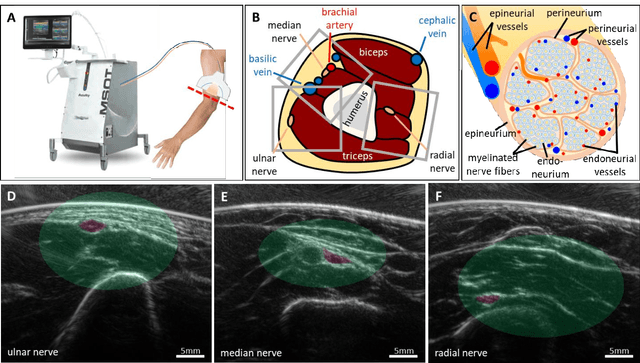

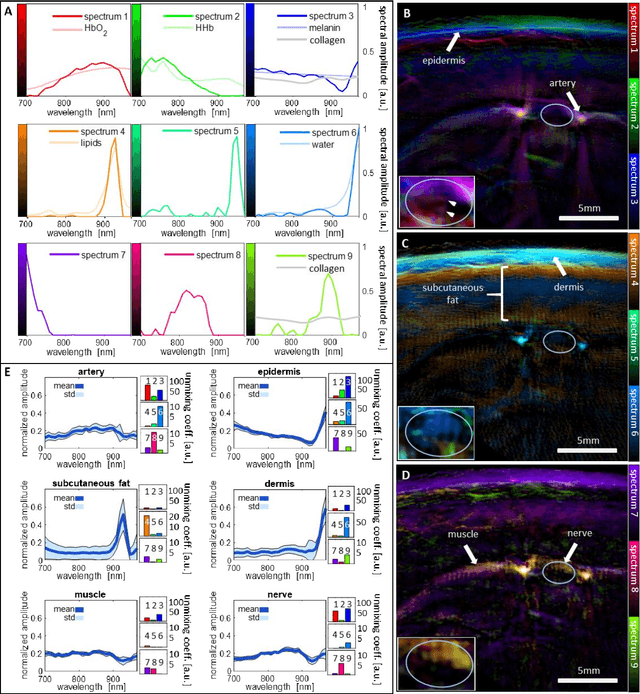
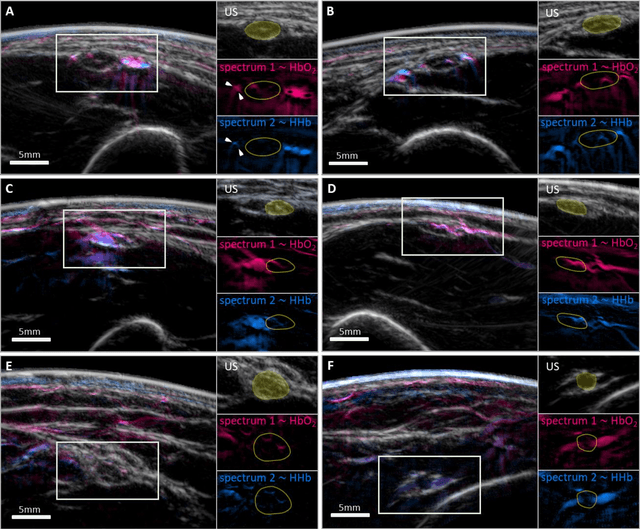
Abstract:Various morphological and functional parameters of peripheral nerves and their vascular supply are indicative of pathological changes due to injury or disease. Based on recent improvements in optoacoustic image quality, we explore the ability of multispectral optoacoustic tomography, in tandem with ultrasound imaging (OPUS), to investigate the vascular environment and morphology of peripheral nerves in vivo in a pilot study on healthy volunteers. We showcase the unique ability of optoacoustic imaging to visualize the vasa nervorum by observing intraneurial vessels in healthy nerves in vivo for the first time. In addition, we demonstrate that the label-free spectral optoacoustic contrast of the perfused connective tissue of peripheral nerves can be linked to the endogenous contrast of haemoglobin and collagen. We introduce metrics to analyze the composition of tissue based on its optoacoustic contrast and show that the high-resolution spectral contrast reveals specific differences between nervous tissue and reference tissue in the nerve's surrounding. We discuss how this showcased extraction of peripheral nerve characteristics using multispectral optoacoustic and ultrasound imaging can offer new insights into the pathophysiology of nerve damage and neuropathies, for example, in the context of diabetes.
DeepMB: Deep neural network for real-time model-based optoacoustic image reconstruction with adjustable speed of sound
Jun 29, 2022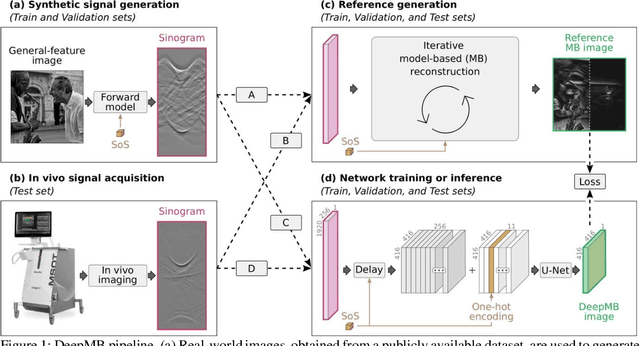
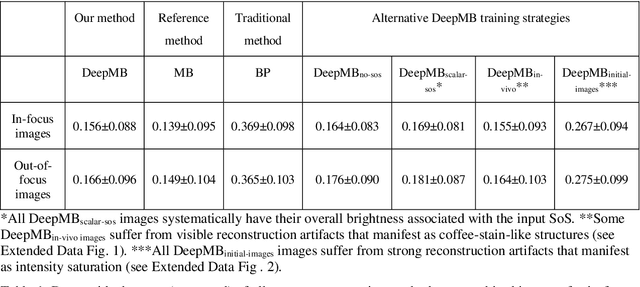
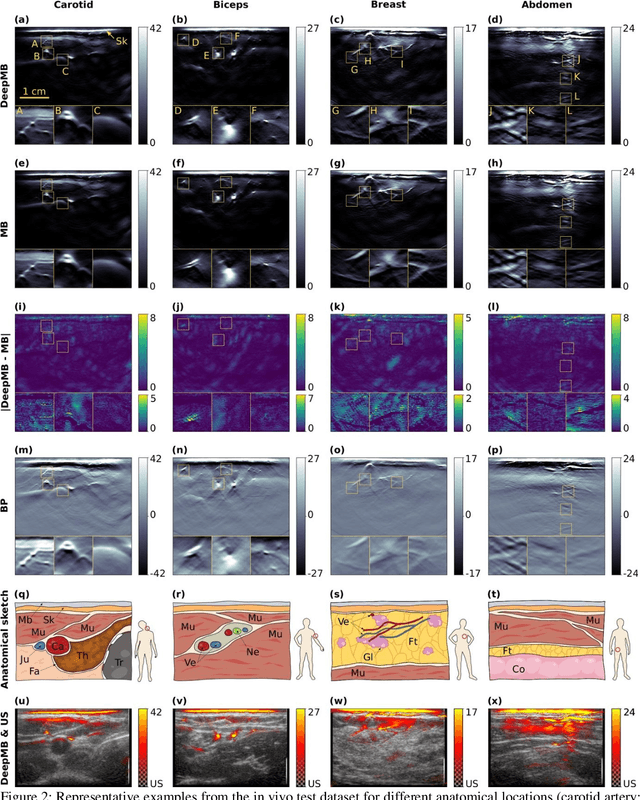
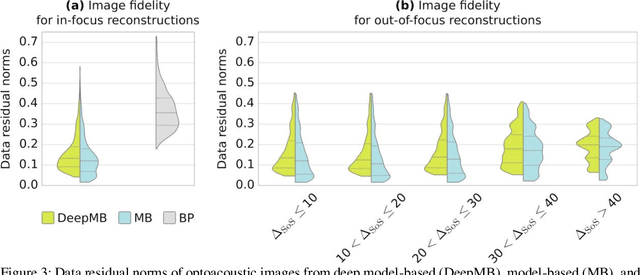
Abstract:Multispectral optoacoustic tomography (MSOT) is a high-resolution functional imaging modality that can non-invasively access a broad range of pathophysiological phenomena by quantifying the contrast of endogenous chromophores in tissue. Real-time imaging is imperative to translate MSOT into clinical imaging, visualize dynamic pathophysiological changes associated with disease progression, and enable in situ diagnoses. Model-based reconstruction affords state-of-the-art optoacoustic images; however, the advanced image quality provided by model-based reconstruction remains inaccessible during real-time imaging because the algorithm is iterative and computationally demanding. Deep-learning may afford faster reconstructions for real-time optoacoustic imaging, but existing approaches only support oversimplified imaging settings and fail to generalize to in vivo data. In this work, we introduce a novel deep-learning framework, termed DeepMB, to learn the model-based reconstruction operator and infer optoacoustic images with state-of-the-art quality in less than 10 ms per image. DeepMB accurately generalizes to in vivo data after training on synthesized sinograms that are derived from real-world images. The framework affords in-focus images for a broad range of anatomical locations because it supports dynamic adjustment of the reconstruction speed of sound during imaging. Furthermore, DeepMB is compatible with the data rates and image sizes of modern multispectral optoacoustic tomography scanners. We evaluate DeepMB on a diverse dataset of in vivo images and demonstrate that the framework reconstructs images 3000 times faster than the iterative model-based reference method while affording near-identical image qualities. Accurate and real-time image reconstructions with DeepMB can enable full access to the high-resolution and multispectral contrast of handheld optoacoustic tomography.
Deep learning based electrical noise removal enables high spectral optoacoustic contrast in deep tissue
Feb 24, 2021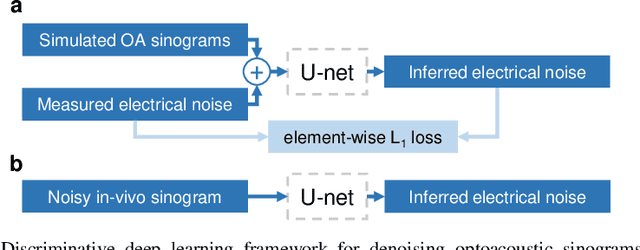
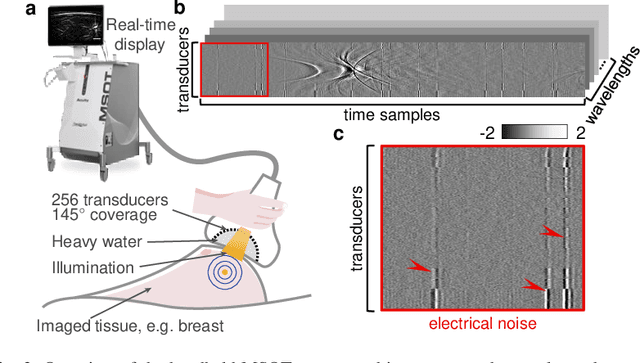
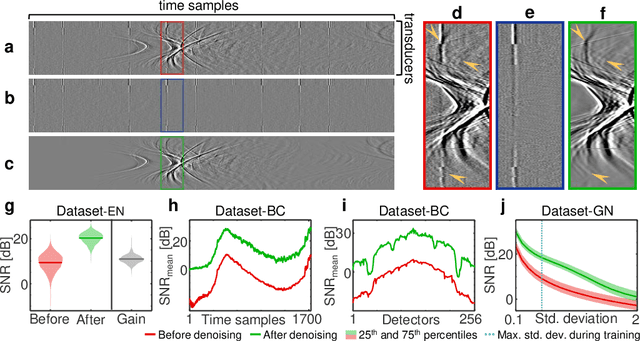
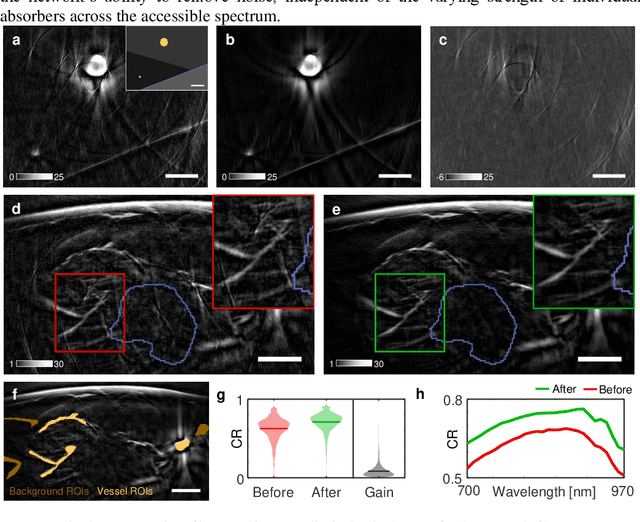
Abstract:Image contrast in multispectral optoacoustic tomography (MSOT) can be severely reduced by electrical noise and interference in the acquired optoacoustic signals. Signal processing techniques have proven insufficient to remove the effects of electrical noise because they typically rely on simplified models and fail to capture complex characteristics of signal and noise. Moreover, they often involve time-consuming processing steps that are unsuited for real-time imaging applications. In this work, we develop and demonstrate a discriminative deep learning (DL) approach to separate electrical noise from optoacoustic signals prior to image reconstruction. The proposed DL algorithm is based on two key features. First, it learns spatiotemporal correlations in both noise and signal by using the entire optoacoustic sinogram as input. Second, it employs training based on a large dataset of experimentally acquired pure noise and synthetic optoacoustic signals. We validated the ability of the trained model to accurately remove electrical noise on synthetic data and on optoacoustic images of a phantom and the human breast. We demonstrate significant enhancements of morphological and spectral optoacoustic images reaching 19% higher blood vessel contrast and localized spectral contrast at depths of more than 2 cm for images acquired in vivo. We discuss how the proposed denoising framework is applicable to clinical multispectral optoacoustic tomography and suitable for real-time operation.
 Add to Chrome
Add to Chrome Add to Firefox
Add to Firefox Add to Edge
Add to Edge